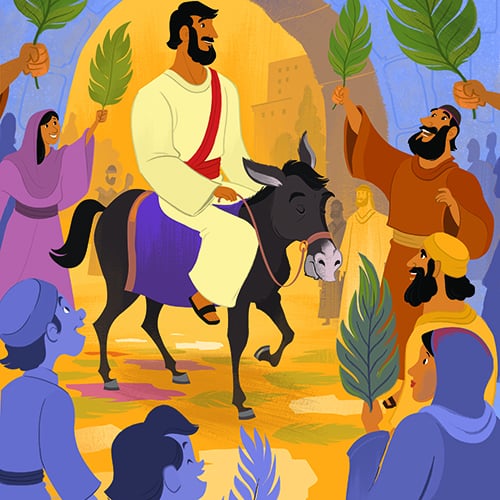The Triumphal Entry on Palm Sunday
 Palm Sunday has become a recognized “occasion” in our culture, but many people don’t know what the day is about and even fewer understand the meaning of the original Palm Sunday. Palm Sunday is the day on which we celebrate the entry of Jesus into Jerusalem on the Sunday before His crucifixion and a week before His resurrection. We refer to this event as the “Triumphal Entry” because the people welcomed and praised Jesus as their long-awaited Messiah/King. They even placed palm branches on the road ahead of his entrance. This is why we call it Palm Sunday. But what was Jesus trying to accomplish and what was the meaning of this majestic event?
Palm Sunday has become a recognized “occasion” in our culture, but many people don’t know what the day is about and even fewer understand the meaning of the original Palm Sunday. Palm Sunday is the day on which we celebrate the entry of Jesus into Jerusalem on the Sunday before His crucifixion and a week before His resurrection. We refer to this event as the “Triumphal Entry” because the people welcomed and praised Jesus as their long-awaited Messiah/King. They even placed palm branches on the road ahead of his entrance. This is why we call it Palm Sunday. But what was Jesus trying to accomplish and what was the meaning of this majestic event?
Timing Matters
The Triumphal Entry of Jesus into Jerusalem on Palm Sunday must be considered in its immediate historical context in order to be understood. The details of the event are recorded in all four Gospels which underscores its significance. What we learn from the various accounts is that the Triumphal Entry essentially kicked off the beginning of the final week of Jesus’ life; what we call the Passion Week. If we identify all of the distinct events in the life of Jesus that are recorded in the Gospels, we come up with 229 separate events. Of these 229 events, a quarter of them (56) occur in this final week.
The broader context of Jesus’ ministry reveals that Jesus was deliberately moving toward this week and what He knew would be His execution at the hands of the Romans. It’s clear from many passages that Jesus was managing the circumstances (and the level of animosity toward Him) so that He would die precisely on the Passover. This would demonstrate that He truly was “the Lamb of God, who takes away the sin of the world” (John 1:29).
The Passion Week, then, becomes enormously important in the grand scheme of Jesus’ ministry. The events of this week, including the Triumphal Entry, are all being carefully orchestrated by Jesus to lead up to His crucifixion. The Gospel writers each recorded the events of this final week in order to teach important truths and demonstrate that Jesus was the promised Messiah/King who would die as the ultimate Passover sacrifice. It is in that context that the Triumphal Entry on Palm Sunday takes place and must be understood.
Palm Sunday and the Passover
The Passover was one of the most significant festivals on the Jewish calendar. It celebrated the original Passover event in which the enslaved Hebrews placed the blood of a lamb over their doors as a sign of their identification with their God and their faith in Him (Exod. 12:13). That night the Lord “passed over” Egypt and “every firstborn male in the land of Egypt” died (Exod. 11:5). Only those protected by the blood of the lamb were spared. This event would mark the beginning of the Jewish New Year (Exod. 12:2) and functioned effectively as a birthday for the nation as God delivered them from slavery and they began their journey to Sinai and the Promised Land.
It was for the Passover “festival” (John 12:12) that Jews flooded to Jerusalem for the week. The roads to Jerusalem would have been filled with faithful Jews making their way to the city. All four Gospel writers (Matt. 21:8, Mark 11:8, Luke 19:37, John 12:12) make it clear that there was a crowd of people present. Like Jesus, they were coming for the Passover.
A Humble Ride and Fulfillment of Scripture
As Jesus and His disciples approached the city on foot, He sent two of His disciples ahead to acquire a “young donkey” on which He would enter the city. It is not clear from the text whether this young donkey was prearranged or Jesus somehow knew by divine revelation that the donkey would be waiting. This would not be the first time Jesus demonstrated special knowledge, but it’s entirely possible that earlier arrangements had been made. Jesus had been to this area before and knew people in this area, so arranging for the donkey would not have been difficult or unreasonable.
Matthew (21:4-5) and John (12:14) both note that Jesus’ riding on a young donkey was intended to fulfill the prophecy by Zechariah… “Fear no more, Daughter Zion. Look, your King is coming, sitting on a donkey’s colt” (Zech. 9:9). In fact, the collective record of the entire event is designed to connect Jesus with the Old Testament prophecies in order to show that He really was the anticipated Messiah of the Scriptures.
Excitement and Anxiety
We don’t know exactly how long it had been since Jesus had raised Lazarus from the dead, but John had already noted that “the Jewish Passover was near” (John 11:55). It was for that reason that the people “were looking for Jesus and asking one another as they stood in the temple complex: ‘What do you think? He won’t come to the festival, will He?'” (John 11:56). It’s clear that there was a “buzz” in the air as a result of Lazarus’ resurrection. Would Jesus, this great prophet who raised people from the dead, dare to come to Jerusalem?
It was this excitement and anticipation that fueled the spontaneous welcome party as Jesus now made His way toward the city on a young donkey. John records an important description of the varying reactions to Jesus’ entrance…
Meanwhile, the crowd, which had been with Him when He called Lazarus out of the tomb and raised him from the dead, continued to testify. This is also why the crowd met Him, because they heard He had done this sign. Then the Pharisees said to one another, “You see? You’ve accomplished nothing. Look — the world has gone after Him!” (John 12:17-19).
The people were excited. The Pharisees were nervous and angry. Jesus knew exactly what He was doing.
The Royal Procession Grows
It was a magnificent day of celebration for the Jewish people. They were expecting a warrior king who would overthrow Roman oppression and reestablish Israel as a national powerhouse as in the days of King David and King Solomon. Many now believed Jesus was this long-awaited King. Perhaps this was the moment they had been anticipating for centuries! What could be more exciting?
As Jesus made His way toward and into the city, the people “took palm branches and went out to meet Him” (John 12:13). Palm branches were used in festive occasions and were often associated with victory and royalty. Palm branches would not have been the only kind of branches quickly cut by the people for the spontaneous occasion. For that matter, branches (of any kind) weren’t the only item used to create a hasty welcome mat for Jesus. Matthew reports that, “a very large crowd spread their robes on the road; others were cutting branches from the trees and spreading them on the road” (Matt. 21:8). All of this was a spontaneous and joyful reaction to the arrival of the One they now believed would be the King for whom they had long been waiting!
Jesus’ entrance into the city was quickly becoming a full-blown, royal procession that would not be so different from a ticker-tape parade in New York welcoming returning heroes from war. Soon the people broke out in shouts of praise…
The King who comes in the name of the Lord is the blessed One. Peace in heaven and glory in the highest heaven! (Luke 19:38).
This declaration, taken from Psalm 118:25-26, would point to Jesus as the fulfillment of their many hopes and dreams. Jesus was everything for which they had waited!
Notice also how Luke’s account (above) reminds us of the angelic announcement of Jesus’ birth in Luke 2:14…
Glory to God in the highest heaven, and peace on earth to people He favors!
The Danger of a New Kingdom
It’s clear from Luke and the other Gospel writers, years later, that the Triumphal Entry is to be seen as a royal event. This is King Jesus, fulfilling the prophecies of the return of God Himself to Jerusalem and the temple. Jesus is Lord. Jesus is the true King of Israel, Rome, and all creation.
The Pharisees certainly understood the frightening implications of such a royal procession into the city of Jerusalem. This was precisely the kind of thing that made the Romans nervous. They were always on watch and eager to crush any suggestion that anyone other than Caesar was king. It was probably for this reason, in part, that the Pharisees who were present among the crowd objected to the royal, if only spontaneous, procession…
Some of the Pharisees from the crowd told Him, “Teacher, rebuke Your disciples” (Luke 19:39).
The Pharisees’ objection certainly reflected concern over the possible Roman reaction, but they also understood that the peoples’ praise was Messianic as well. The Pharisees and the religious structure of that time were not prepared to acknowledge Jesus as Messiah. That would truly change everything and they weren’t ready for that. Jesus was dangerous.
Jesus certainly understood. Changing everything was precisely what He had come to do. That would become even more evident in the events of the coming week. Jesus hints at this in His response to the Pharisees…
He answered, “I tell you, if they were to keep silent, the stones would cry out” (Luke 19:40)!
The Kingship of Jesus (and His Kingdom) would be all encompassing. If the powers of this world could somehow silence the people, creation itself would “cry out!” The Kingdom of God would challenge everything because it was going to establish a new Kingdom that is different. The Kingdom of God was going to restore and redeem the entire universe (Rom. 8:19-22)!
We can be certain that neither the people nor the disciples had a clear understanding of what was happening at the time. For the disciples, this would come later (John 12:16). But the circumstances of the Triumphal Entry contain an interesting twist and convey an important and surprising message.
God Returns to Jerusalem
Prior to the Babylonian Exile (roughly 600 years earlier), the prophets spoke for God and revealed that the peoples’ sin was going to bring judgment and exile (see Jer. 25 as an example). Exile meant separation from the land, but it also meant separation from God Himself and His presence. The presence of God had always been associated with the temple (or tabernacle before the temple). Ezekiel, not long before the exile, provided a rather dramatic picture of God’s glory (and His presence) departing from the temple…
Then the glory of the Lord moved away from the threshold of the temple and stood above the cherubim. The cherubim lifted their wings and ascended from the earth right before my eyes… (Ezek. 10:18-19a).
Without the presence of God, the temple would be unprotected and vulnerable. In 587 B.C., the Babylonians destroyed Jerusalem and the temple with it. The people were carried into captivity and the exile was well under way. The worst that could happen DID happen. The people were separated from God and the land He had given them.
By 517 B.C., many of the people had been allowed to return from Babylon, rebuild the temple, and dedicate it to the Lord. When Solomon’s temple (the first temple) was dedicated, it was filled with the visible glory of God (1 Kings 8:10). Surely, some 70 years later, the people were hoping that exile was formally and finally over. God would return to the temple and restore Israel to it’s former glory. It didn’t happen. According to Daniel 9:24, the true exile would continue for 490 years.
For these five centuries the people had been waiting for the return of God’s glory; for the return of God Himself. They knew Daniel’s prophecy and knew the time had been fulfilled. When would God return to Jerusalem and His temple? When Jesus entered Jerusalem this final time in a royal procession and allowed the people to declare He was King, Jesus was Himself declaring that He was the long-awaited King. He was the long-awaited presence of God, returning to the temple after more than 500 years. Jesus was God, and He was finally coming back!
Palm Sunday Was a Surprise
But there’s a surprise twist in the Triumphal Entry. Jesus was certainly the long-awaited King and returning presence of God, but He was not the kind of King they were expecting. The people were expecting a military ruler to lead in battle against the Romans. Instead, Jesus advocated turning the cheek, even for the Romans. The people were expecting a king on a war horse. Instead, Jesus was riding on a donkey. The people wanted an army. Instead, Jesus had a small group of unarmed disciples. Palm Sunday presented a very different, and surprising, kind of King.
Perhaps this is partly why public sentiment could turn so quickly away from Jesus. He was, in fact, the King for whom they had waited, but He was not going to be the KIND of king for which they had hoped.
That week Jesus would cleanse the temple and redefine what it meant to be a Jew, but rather than lead a rebellion against Rome, Jesus would be crucified by Rome.
The Real Battle
The Triumphal Entry on Palm Sunday points forward to Jesus’ mission to die as the true King in order to defeat the true powers of evil and bring genuine forgiveness. Palm Sunday reveals that the real battle is not an earthly battle against earthly powers like Rome. When Jesus was before Pilate just days later, He made this clear…
“My kingdom is not of this world,” said Jesus. “If My kingdom were of this world, My servants would fight, so that I wouldn’t be handed over to the Jews. As it is, My kingdom does not have its origin here” (John 18:36).
Palm Sunday should remind us that Jesus is a different kind of King than we often anticipate, hope for, or want. We want Jesus to serve OUR aspirations and establish OUR kingdoms. But Jesus’ Kingdom doesn’t serve me, or you. His Kingdom is “not of this world.” Jesus calls me to serve HIS kingdom and that changes everything. Jesus calls me to engage in the REAL battle that is taking place between good and evil. King Jesus calls me to join Him in accepting the tasks that come from the kind of humility that allows the true King to ride on a donkey rather than a war horse.
Teaching Children About Palm Sunday
Children are not nearly as hung up on worldly power as adults are. As we struggle to earn a living, provide for our families, and advance our careers, we adults begin to believe that the things of this world define true power. Children find it much easier to believe that the Jesus of the Gospels is the rightful King of the world and the One who wields true power.
Children can easily imagine the Jesus they love riding on a donkey. Children don’t need to outfit Jesus in armor to see Him as Lord of all. It’s not difficult for kids to understand that the people praising Jesus on Palm Sunday were expecting Him to be a different kind of king. Children need to hear the details of the story, but they also need to see the contrast between who Jesus was and what the people were expecting. The Triumphal Entry on Palm Sunday declares that Jesus is, in fact, the King of kings, but He’s not the kind of King we often want or expect. Kids can learn this rather easily, but we need to help them see it.
The free Bible activities on Sunday School Zone related to Palm Sunday will help kids learn about the event and see the Jesus of the Gospels as the true Lord and King.
You can go to GotQuestions.org to learn more about Palm Sunday by reading this interesting article.



